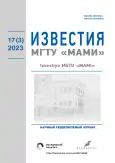Analysis of prospects for improvement and development of vehicle suspension structures
- Authors: Martynov E.N.1, Potashov I.S.1, Bokarev A.I.1
-
Affiliations:
- Central Scientific and Research Institute of Automobiles and Automotive Engines NAMI
- Issue: Vol 17, No 3 (2023)
- Pages: 273-286
- Section: Transport and transport-technological complexes
- URL: https://journal-vniispk.ru/2074-0530/article/view/249928
- DOI: https://doi.org/10.17816/2074-0530-138656
- ID: 249928
Cite item
Full Text
Abstract
BACKGROUND: The growth of consumer expectations from an automaker encourages engineers to develop and implement new design, technical and electronic solutions in various vehicle systems to ensure the stability of the vehicle’s consumer attributes at low and high speeds in a variety of road conditions. In the direction of achieving the required consumer attributes of a vehicle, the design of the suspension links plays a decisive role. There is a wide variety of design and technical solutions, so the task of conducting a review study to reflect the trend in suspension architecture development becomes relevant.
AIMS: Determination of the trend in the development of design and technical solutions used in the vehicle chassis, aimed to improve the operational attributes of a vehicle such as stability, handling, ride smoothness and reliability.
METHODS: Methods of statistical analysis.
RESULTS: The results are presented in the form of a systematic statistical study of design and technical solutions used in the vehicle chassis, aimed to improve the operational attributes of a vehicle.
CONCLUSIONS: The result obtained can be applied for the correct goal setting in the development of passenger cars.
Full Text
##article.viewOnOriginalSite##About the authors
Evgeniy N. Martynov
Central Scientific and Research Institute of Automobiles and Automotive Engines NAMI
Author for correspondence.
Email: martynoff.evgeny2015@yandex.ru
Postgraduate, Design Engineer of the 2nd Category
Russian Federation, MoscowIlya S. Potashov
Central Scientific and Research Institute of Automobiles and Automotive Engines NAMI
Email: ilya.potashov@nami.ru
SPIN-code: 8741-2992
Design Engineer of the 1st Category
Russian Federation, MoscowAlexander I. Bokarev
Central Scientific and Research Institute of Automobiles and Automotive Engines NAMI
Email: bokarev@bmstu.ru
ORCID iD: 0000-0003-3617-2747
SPIN-code: 8178-5744
Cand. Sci. (Tech.), Lead Design Engineer
Russian Federation, MoscowReferences
- Pevzner YaM. Vehicle stability theory. Moscow: GNTI Mashgiz; 1947. (In Russ).
- Gintsburg LL. Stability of the controlled movement of the car relative to the trajectory. Moscow: Avtomobilnaya promyshlennost. 1977. № 9. С. 27. (In Russ).
- Karunin AL. Vehicle design. Chassis. Moscow: MAMI; 2000. (In Russ).
- Ostretsov AV. Car pendants. Moscow: MAMI; 2011. (In Russ).
- Reimpel J. Car chassis. Moscow: Mashinostroenie; 1983. (In Russ).
- Antonov AS. Army vehicles. Design and calculation. Part 1. Moscow: Voenizdat; 1970. (In Russ).
- Vakhlamov VK. Cars. Design and calculation elements. Moscow: Akademiya; 2006. (In Russ).
- Polungyan AA. Design of all-wheel drive wheeled vehicles. Vol. 1. Moscow: MGTU im NE Baumana; 1999. (In Russ).
- Ersoy M. Chassis Handbook. Fachmedien, Wiesbaden: Springer; 2011.
- Reimpell J. The Automotive Chassis: Engineering Principles. Warrendale: Society of Automotive Engineers Inc.; 2002. PA 15096-0001.
- Buechner S. Enhanced Characterization of Suspension Systems for Virtual Chassis Development. Munich: BMW Group, Institute of Automotive Technology, Technical University of Munich, 2020.
- Porvatov I.N., Kristalny S.R. Classification and marking of cars. Methodical instructions for practical exercises in the discipline “Fundamentals of car design”. Moscow: MADI; 2010. (In Russ).
- Advancements in electric and hybrid electric vehicle technology SAE SP-1023. Warrendale: Society of Automotive Engineers, 1994.
- Zelenin SF, Molokov VM. Car Tutorial. Moscow: RusAvtokniga; 2000. (In Russ).
- Honda vs. Mazda 4-wheel-steering // Popular science. 1987.
- Operational and Design Features of the Steer Angle Dependent Four-Wheel Steering System, Eleventh International Technical Conference on Experimental Safety Vehicles, p. 404–415, May 12–15, 1987.
- Improved Handling and Stability Using Four-Wheel Steering, Eleventh International Technical Conference on Experimental Safety Vehicles, p. 415–425, May 12–15, 1987.
Supplementary files

















